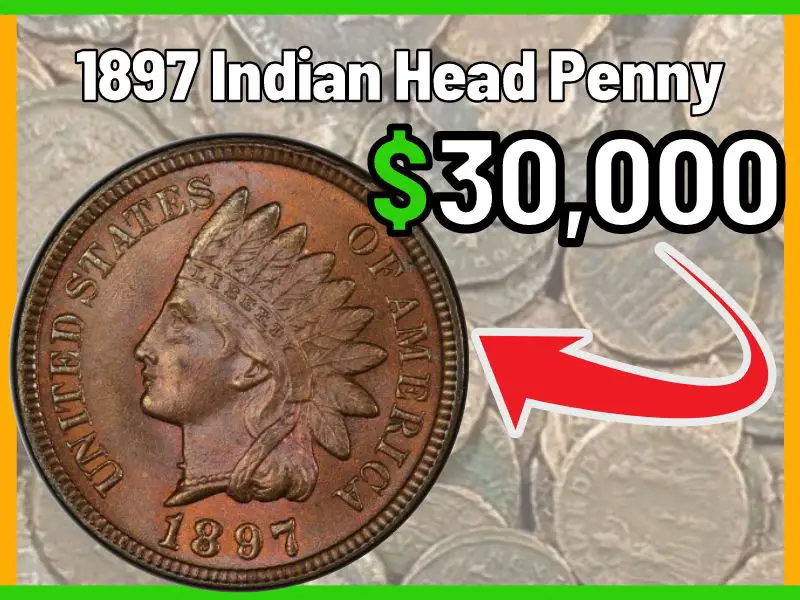
The 1897 Indian Head Penny is worth $3.89 in average condition and can be worth $45 to $74 or more in uncirculated (MS+) mint condition. Proof coins can be worth $169 or more.
Are you wondering what the value of your 1897 Indian head penny is? Are you looking to sell? Here’s where I’ll tell you the most important information about the value of this coin.
If you’re searching for the 1897 Indian Head penny value, you’ve probably heard conflicting stories. Some websites say the coin is worth anywhere from a few dollars to several hundred dollars. According to what I found, this is right on track. The older pennies are more valuable and rarer than the new ones, so your coin could be worth quite a bit if it bears the 1897 date.
So, how much is a 1897 Indian Head Penny worth? Read on to find out more information on the worth of your old penny.
1897 Indian Head Penny
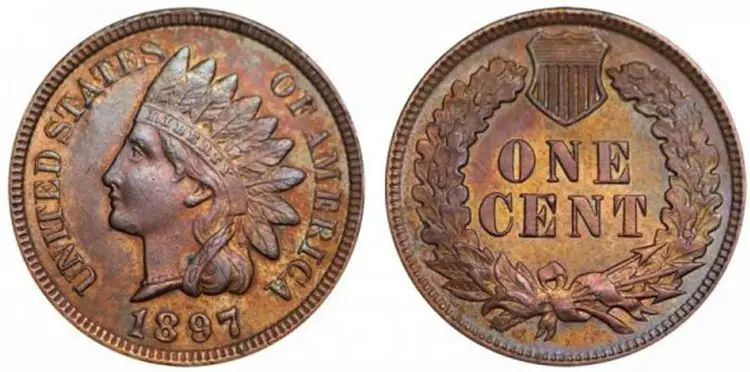
Among the most popular of United States coinage, Indian Head Pennies are treasured by collectors. These coins were widely used in trade throughout much of the nineteenth century and well into the twentieth century. Thanks to this fact, Indian Head Pennies are the object of desire for so many collectors.
The 1897 Indian Head is one of the last editions produced, making it one of the newest, and many copies have survived. Collectors look for coins in the best condition possible and not many well-preserved 1897 Indian Heads have been able to survive the 100+ year journey.
History
The Indian Head cent was a one-cent coin produced by the United States Bureau of the Mint from 1859 to 1909. It was designed by James Barton Longacre, the Chief Engraver at the Philadelphia Mint.
From 1793 to 1857, the cent was a copper coin about the size of a half dollar. The price of copper rose when gold became more abundant in California. Because cent and half-cent manufacture were one of the Mint’s only profit centers, it began looking for alternatives by 1850.
| 1897 Indian Head Penny | |
| Location | Minted |
| Philadelphia | 50,464,392 |
The Mint reduced the size of the cent in 1857 and changed its composition to 12% nickel and 88% copper, issuing a new design, the Flying Eagle cent. These were the first United States coins made of copper-nickel. They were called “White cents” or “Nicks” because they looked brighter than previous types of U.S. coins.
Indian Head cents minted From 1859-1864 belong to the copper-nickel category, coins in this category contained 88% of Copper and 12% Nickel. Coins struck from 1864-1909 belong to the bronze composition as they contain 95% Copper and 5% Zinc and Tin.
In 1858, the Flying Eagle design was replaced with the Indian head design. The Mint had been having trouble with the Flying Eagle design and decided to replace it. Mint Director James Ross Snowden chose the Indian Head design and replaced the laurel wreath on the reverse with an oak wreath with a shield.
| 1897 Indian Head Penny | |
| Metal Composition | 95% Copper – 5% Tin and Zinc |
| Mass/Weight | 3.11 grams |
| Diameter | 19 mm |
| Mint Mark | No Mint Mark |
| Edge | Plain |
| Designer | James B Longacre |
The Indian Head cent was first produced for commerce in 1859. As issued for circulation, the piece differs from the pattern of the same year in some particulars; Longacre sharpened some details. In the postwar years, the production of cents was reduced, as hoarding ceased and some of the slack was taken up by other base-metal coins.
The Panic of 1893 caused another decrease in the number of cents produced, as people were reluctant to spend their coins and a surplus accumulated. The final years of the series before its termination in 1909 were marked by high mintages, with 1907 topping the 100 million mark.
The 1897 Indian Head Penny like most was struck in the Philadelphia mint, a total of 50,464,392 coins were minted, which means a lot of those coins went into circulation, however, a good number of coins were preserved and most have already been sold in auctions. Today, 1897 is a very rare coin to find especially in higher grades, the PCGS has graded not so many.
Indian Head cents were popular with coin collectors for more than 50 years after their discontinuation; the hobby of coin collecting has grown, so interest in the coin has increased. It was not until the 1960s that they began to be studied in-depth; Tom DeLorey, in his introduction to Snow’s book, attributes this to prejudice among numismatists who grew up with the Indian Head cent as a common circulation piece.
Design
Numismatic legend has it that the facial features of the goddess Liberty on the obverse of the Indian Head cent were based on those of Longacre’s daughter Sarah; according to this story, she was at the mint one day when she tried on the headdress of one of a number of Native Americans who was visiting, and her father sketched her.
However, in the story, Sarah Longacre was 12 years old and not 30 as she was in real life when she created the face, and Longacre himself stated that the face was based on a statue of Crouching Venus in Philadelphia on loan from the Vatican.
Although Longacre’s portrait of an “Indian” features a man’s headdress, the face is essentially Caucasian and therefore a Caucasian woman wears the headdress of a Native American man. Longacre’s design for the three-dollar piece in 1854 featured a female with similar features, but a more fanciful headdress. He then adapted that design for the gold dollar.
Obverse
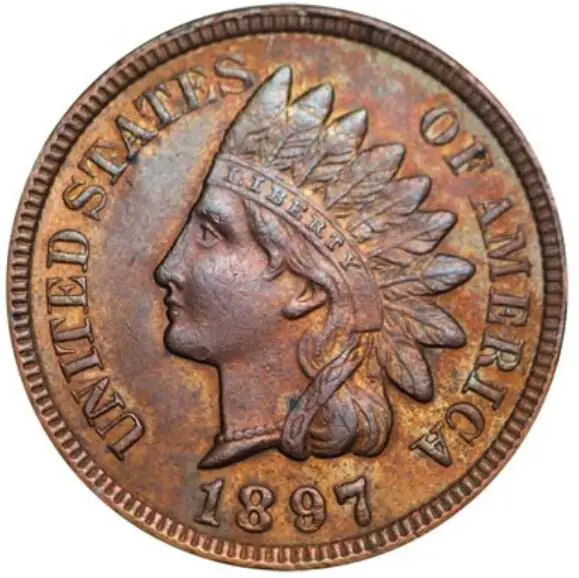
The Obverse was designed by James B Longacre and it depicts Lady Liberty wearing an Indian Native hat. The date is also featured on the obverse, in this case, “1897” The date is located just below the portrait of Lady Liberty facing right. The words “UNITED STATES OF AMERICA” spans across the obverse of the coin. Another important detail is the word “LIBERTY” inscribed on the cap, this was probably done to properly depict Lady Liberty. No mint mark or designer initials is on the obverse of the coin.
Reverse
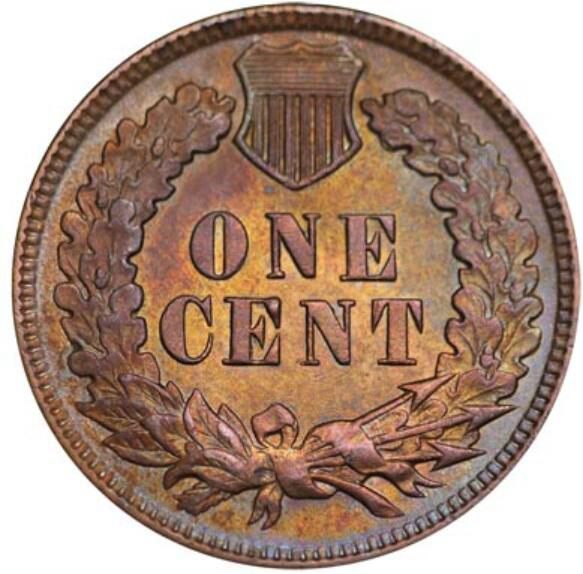
The reverse design was also done by James B Longacre and it has a lot of detail on it. The words “ONE CENT” are boldly inscribed on the back side of the coin and surrounded by a wreath. The Wreath has hidden details that can only be seen with proper examination using a magnifying glass. On the wreath, you’d find an Acorn, olive leaves, fruit, a ribbon knot, oak leaves, and arrows. The ribbon appears to be holding the arrows to the wreath. This is an indication that the United States loves peace but can protect itself if the need arises.
There’s also a shield just above the “ONE CENT.” As you have seen, the Indian Penny does not have so many words on the reverse.
Philadelphia Mint
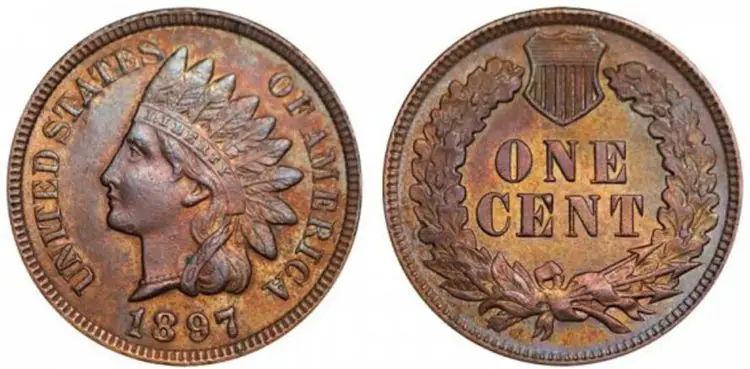
Only the Philadelphia mint produced the Indian Head Penny throughout its history, the only exception was the 1909 S Indian head penny which was struck in the San Francisco mint. It is known to be one of the most valuable Indian Head Cents.
The Philadelphia mint was known for producing the Indian Head Penny in large numbers, only a few years later there was a shortage in production. In 1897, the total number of coins minted in the Philadelphia mint, bearing the 1897 date on the obverse was 50,464,392. A lot of these coins went into circulation. For a coin over 120 years old, not a lot of pristine condition coins exist.
The mint didn’t include mint marks on the obverse or reverse of the Indian Head Penny.
Grading The 1897 Indian Head Penny
A coin collector values a coin’s condition above all else. The fact that no one wants to add a beat-up, tattered coin to their collection means that every person seeking out one of these coins is also seeking out one in great shape.
To grade a coin is to determine its condition. Grading can be done by a professional company, but you can also go about it yourself by judging your piece’s qualities. The following specifications may help you to understand more about what conditions are indicative of certain grades.
Uncirculated: An Uncirculated Indian Head Penny is one that was never circulated. These coins show no signs of wear, and are in absolutely perfect condition. The only problem with these coins is that some of their luster has worn away over time, but apart from that they are in pristine condition. Uncirculated coins have a mirror-like finish and are often shiny. They have not been in circulation for any length of time, so their condition is as close to perfect as you can get. Because of this, they are highly prized by collectors and investors alike.
Extremely Fine: To receive an Extremely Fine grade, the coin will have been circulated for only a short period of time. Apart from a few isolated scratches, it is in pretty good shape for being well over 100 years old. The raised images and inscriptions are still legible, and the imagery should be in near-perfect condition. The coin will be free of any major marks or blemishes and should have a nice shine to it. If you have an Extremely Fine 1897 Indian Head Cent in your collection, it is likely worth quite a bit more than its face value.
Fine: Although this coin spent quite a few years in circulation, its overall level of wear is not such that the coin is unattractive. All of the coin’s inscriptions and imagery will be able to be deciphered with the naked eye. But the coin’s surface will have been slightly worn by the hands of previous owners. The coin’s surface will be smooth, but not completely flat. The coin will have some small areas of wear, which may include light scratches or nicks.
Good: Coins that have received this grade have been heavily circulated and do not look particularly good. The imagery is still there, as are the inscriptions, but they are difficult to make out without magnification. Plus, the faces of the coin will be smooth, as most of the raised aspects of the coin will have been worn down through being circulated during its lifetime. If you are looking for a coin that has been worn down but still looks good, then this is the grade for you. If you want something that is in pristine condition, however, then you will want to look elsewhere.
1897 Indian Head Penny Value
Assessing the Indian Head Penny price is a simple matter of determining the coin’s condition. Additionally, since the 1897 edition of the coin is relatively newer, many of them have survived. As a result, even Indian Head pennies in pristine condition are quite affordable. Those coins in poor shape are incredibly affordable.
Along with being one of the most beautiful designs ever minted, the Indian 1897 penny is extremely valuable. In fact, demand is so high that despite a mintage of nearly 51 million pieces, they can be difficult to find in uncirculated condition.
Year |
G |
VG |
F |
VF |
XF |
AU 50 |
1897 |
$3.30 |
$3.89 |
$5.70 |
$9.13 |
$17 |
$28 |
If you have an 1897 Indian Head penny, it is increasing in value. Demand for this series of old coins remains high with both new and experienced collectors. Although many Indian pennies were destroyed, a large number still exist. However, most are heavily worn, leaving only a small number of better quality. The result: If your coin is above average in condition it is avidly collected and its value increases by as much as 200 percent.
Note: Coin collectors pay a great deal of attention to wear, marks, and the color of old Indian pennies.
1897 Indian Head Penny Value & Price Chart
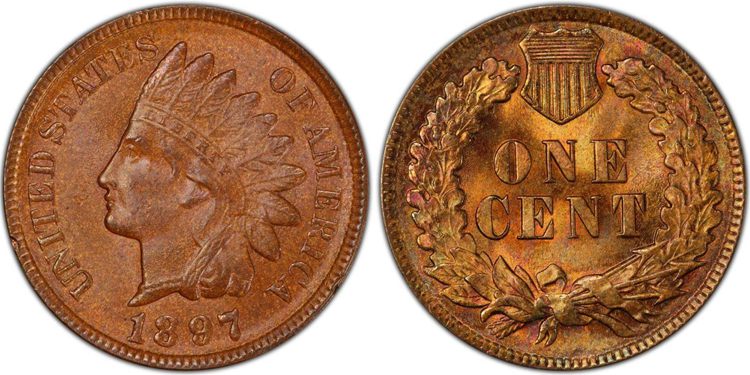
The 1897 Indian Head penny is worth $3.89 in average condition and can be worth $45 to $74 or more in uncirculated (MS+) mint condition. Proof coins can be worth $169 or more.
The 1897 Indian Cent is a common issue in the Indian Cent Series, making it an ideal type coin. Several circulated examples are available at any time. For uncirculated coins to be scarce and valuable, they must have at least some red coloring. The finest gems can be rare.
As the American economy rebounded from the Panic of 1893, the mint began producing more cents. This means that examples of the coin in all grades except for red gems are plentiful. This is an issue that can be challenging in the best of circumstances, being one of the scarcer dates of this decade.
Grade |
Price Sold |
MS 62 |
|
MS 63 |
|
MS 64 |
|
MS 65 |
What year is the most valuable Indian head penny?
The most valuable Indian Head Penny is the one from 1877. However, all pennies from that time period are valuable in their own right and any collector would be lucky to have one. The 1877 Indian Head Penny has one of the lowest mintage figures, it is considered to be a very rare coin, even the worst grade could fetch up to $1000 in the open market. The price of the 1877 Indian Head Penny increases with time.
Selling And Buying The 1898 Indian Head Penny
eBay
The best place to buy an 1897 Indian Head penny is on eBay. You’ll find a couple of listings for the coin at any time of day or night, with prices ranging between $10 and $20,000. If you’re looking to sell your coin, you can post it for sale at any time, but be aware that someone might pay more than what you asked for. If you don’t get enough offers or if you feel like you need help selling your coin, consider using an online auction house like Heritage Auctions or Stack’s Bowers Galleries instead of eBay.
Coin Shows
Coin shows are a great place to buy or sell coins because there are usually several dealers who specialize in different types of coins. You will find many of them at coin shows that specialize in Indian head pennies or other old coins. If you can’t make it to an event like this, another option is to ask around at local coin shops or even ask your friends and family members if they know anyone who sells old coins online.
Coin dealers
Coin dealers typically have larger inventory than eBay sellers. They usually carry more rare varieties and lower mintage numbers that may not be available on eBay. They also tend to have better prices because they don’t have to pay PayPal fees like eBay sellers do when you win an auction and pay for your item through PayPal.
Final Words
Whether you are just starting out as a collector and looking for an affordable coin to start with or are an experienced collector just looking for a different kind of challenge, rare and collectible pennies can fill both roles nicely. If you are starting off as a collector, do some research on how to properly care for and store these unique coins. The 1897 Indian Head Penny seems like a promising investment. Note: This isn’t financial advice, do your research before investing in any coin. Thanks for stopping by.
